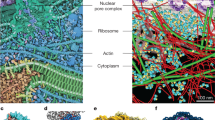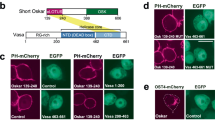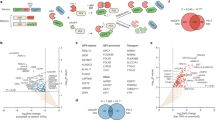Abstract
Conformational conversion of the cellular PrPC protein to PrPSc is a central aspect of the prion diseases, but how PrP initially converts to this conformation remains a mystery. Here we show that PrP expressed in the yeast cytoplasm, instead of the endoplasmic reticulum, acquires the characteristics of PrPSc, namely detergent insolubility and a distinct pattern of protease resistance. Neuroblastoma cells cultured under reducing, glycosylation-inhibiting conditions produce PrP with the same characteristics. We therefore describe what is, to our knowledge, the first conversion of full-length PrP in a heterologous system, show the importance of reducing and deglycosylation conditions in PrP conformational transitions, and suggest a model for initiating events in sporadic and inherited prion diseases.
This is a preview of subscription content, access via your institution
Access options
Subscribe to this journal
Receive 12 print issues and online access
$209.00 per year
only $17.42 per issue
Buy this article
- Purchase on Springer Link
- Instant access to full article PDF
Prices may be subject to local taxes which are calculated during checkout




Similar content being viewed by others
References
Prusiner, S. B. Prions. Proc. Natl Acad. Sci. USA 95, 13363 –13383 (1998).
Weissmann, C. Molecular biology of prion disease. Trends Cell Biol. 4, 10 (1994).
Caughey, B. & Chesebro, B. Prion protein and the transmissible spongiform encephalopathies. Trends Cell Biol. 7, 56–62 (1997).
Bolton, D. C., McKinley, M. P. & Prusiner, S. B. Identification of a protein that purifies with the scrapie prion. Science 218, 1309– 1311 (1982).
Bueler, H. et al. Mice devoid of PrP are resistant to scrapie. Cell 73, 1339–1347 ( 1993).
Horwich, A. L. & Weissman, J. S. Deadly conformations — protein misfolding in prion disease. Cell 89, 499–510 (1997).
Chesebro, B. BSE and prions: uncertainties about the agent. Science 279, 42–43 (1998).
Collinge, J., Sidle, K. C., Meads, J., Ironside, J. & Hill, A. F. Molecular analysis of prion strain variation and the aetiology of ‘new variant’ CJD. Nature 383, 685–690 (1996).
Telling, G. C. et al. Evidence for the conformation of the pathologic isoform of the prion protein enciphering and propagating prion diversity. Science 274, 2079–2082 ( 1996).
Bolton, D. C., Bendheim, P. E., Marmostein, A. D. & Potempska, A. Isolation and structural studies of the intact scrapie agent protein. Arch. Biochem. Biophys. 258, 579–590 (1987).
Caughey, B., Kocisko, D. A., Raymond, G. J. & Lansbury, P. T. Jr Aggregates of scrapie-associated prion protein induce the cell-free conversion of protease-sensitive prion protein to the protease- resistant state. Chem. Biol. 2, 807–817 ( 1995).
Kocisko, D. A., Lansbury, P. T. Jr & Caughey, B. Partial unfolding and refolding of scrapie-associated prion protein: evidence for a critical 16-kDa C-terminal domain. Biochemistry 35, 13434–13442 (1996).
Prusiner, S. B., Groth, D. F., Bolton, D. C., Kent, S. B. & Hood, L. E. Purification and structural studies of a major scrapie prion protein. Cell 38, 127–134 (1984).
Prusiner, S. B. et al. Transgenetic studies implicate interactions between homologous PrP isoforms in scrapie prion replication. Cell 63, 673–686 (1990).
Kocisko, D. A. et al. Species specificity in the cell-free conversion of prion protein to protease-resistant forms: a model for the scrapie species barrier. Proc. Natl Acad. Sci. USA 92, 3923– 3927 (1995).
Holkeri, H., Paunola, E., Jamsa, E. & Makarow, M. Dissection of the translocation and chaperoning functions of yeast BiP/Kar2p in vivo . J. Cell Sci. 111, 749– 757 (1998).
Kopito, R. R. ER quality control: the cytoplasmic connection. Cell 88, 427–430 (1997).
Kopito, R. R. Biosynthesis and degradation of CFTR. Physiol. Rev. (Suppl.) 79, S167–S173 (1999).
Johnston, J. A., Ward, C. L. & Kopito, R. R. Aggresomes: a cellular response to misfolded proteins . J. Cell Biol. 143, 1883– 1898 (1998).
Hegde, R. S. et al. A transmembrane form of the prion protein in neurodegenerative disease. Science 279, 827– 834 (1998).
Mehlhorn, I. et al. High-level expression and characterization of a purified 142-residue polypeptide of the prion protein. Biochemistry 35, 5528–5537 (1996).
Zhang, H. et al. Physical studies of conformational plasticity in a recombinant prion protein. Biochemistry 36, 3543– 3553 (1997).
Jackson, G. S. et al. Reversible conversion of monomeric human prion protein between native and fibrilogenic conformations. Science 283, 1935–1937 (1999).
Acknowledgements
We thank B. Caughey and G. Raymont for providing PrPSc, neuroblastoma cells, epitope-specific antibodies and advice; R. Kascsak for 3F4 antibody; D. Harris for mouse PrP with the 3F4 epitope; D. Ng for pDN182 plasmid; K. Runge forYEpFAT4 plasmid; and members of the Lindquist laboratory for comments. This work was supported by the NIH and the Howard Hughes Medical Institute.
Correspondence and requests for materials should be addressed to S.L.
Author information
Authors and Affiliations
Rights and permissions
About this article
Cite this article
Ma, J., Lindquist, S. De novo generation of a PrPSc-like conformation in living cells. Nat Cell Biol 1, 358–361 (1999). https://doi.org/10.1038/14053
Received:
Revised:
Accepted:
Published:
Issue Date:
DOI: https://doi.org/10.1038/14053
This article is cited by
-
Expression of Tyrosine Hydroxylase is Negatively Regulated Via Prion Protein
Neurochemical Research (2016)
-
How to bake a brain: yeast as a model neuron
Current Genetics (2016)
-
Cellular Prion Protein (PrPC) of the Neuron Cell Transformed to a PK-Resistant Protein Under Oxidative Stress, Comprising Main Mitochondrial Damage in Prion Diseases
Journal of Molecular Neuroscience (2013)
-
Modelling neurodegeneration in Saccharomyces cerevisiae: why cook with baker's yeast?
Nature Reviews Neuroscience (2010)
-
Prion, proteon, proteo-conformer: a terminological analysis
Rendiconti Lincei (2005)



